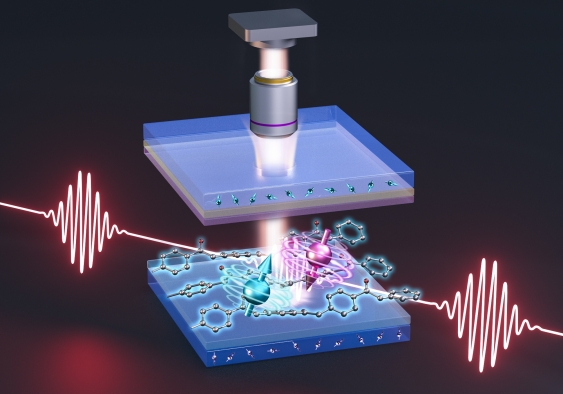Material found in smartphone screens can be harnessed to map magnetic fields
Hand-held magnetic field imaging equipment could be used in construction safety and medical diagnostics.
Hand-held magnetic field imaging equipment could be used in construction safety and medical diagnostics.

Lilly Matson
UNSW Science
0426 656 007
l.matson@unsw.edu.au
Smartphones could one day become portable quantum sensors thanks to a new chip-scale approach that uses organic light-emitting diodes (OLEDs) to image magnetic fields, with significant implications for use in healthcare and industry settings.
UNSW researchers from the ARC Centre of Excellence in Exciton Science, opens in a new window have demonstrated that OLEDs, a type of semiconductor material commonly found in flat-screen televisions, smartphone screens and other digital displays, can be harnessed to map magnetic fields.
The latest research, led by Dr Rugang Geng, opens in a new window and Professor Dane McCamey from the UNSW School of Physics, has been detailed in Nature Communications, opens in a new window.
“Our findings show that OLEDs, a commercially available technology, can be used not only for displays and lighting, but also for quantum sensing and magnetic field imaging by integrating a small piece of microwave electronics,” says first author of the study, Dr Rugang Geng.
“If this technology is properly developed, people could simply use their smartphones to map the magnetic fields around them, for example to spot defects in diamonds or jewellery. This also has applications in industry, such as finding defects in construction materials or as a biomedical sensor.”
OLEDs are a new display technology that provides some of the best quality screens in smartphones and TVs.
“The basic working principle of an OLED device is that when a voltage is applied, electrons and holes are injected into different layers of the device,” says Dr Geng. “When the electrons and holes meet in the central layer, they form ‘excitons’, which emit visible light when they decay, and that’s what makes OLEDs useful as displays and lighting sources.”
This light emission process exploits the charge characteristics of electrons, which have a negative charge, and holes, which have a positive charge. They both also have another intrinsic property called spin.
This spin either points up or down and is very sensitive to external magnetic fields. In fact, it can ‘flip-flop’ (or switch direction) under magnetic resonance conditions.
“By measuring the signal change, both in electric current and emission light, induced by such a flip-flop, we are able to detect the strength of any magnetic field the device is exposed to,” says Dr Geng.
Read more: The 'flip-flop' qubit: realisation of a new quantum bit in silicon controlled by electric signals
By integrating an OLED with a microwave resonator, Dr Geng, Prof. McCamey and their colleagues have generated a tiny oscillating magnetic field across the OLED device, allowing each individual pixel of the OLED screen to act as a small magnetic field sensor.

The spin property of electrons and holes, which meet in the middle layer of the device, either point up or down and are very sensitive to external magnetic fields. Image: Supplied.
“We weren’t surprised at the result – we have been pursuing this for a few years,” says Prof. McCamey. “But we were surprised at the resolution of the images we could make – we can see details on sub-micron length scales, similar to the size of a bacteria or neuron.”
This latest research represents the next step in the development of magnetic field imaging equipment. Existing quantum sensing and magnetic field imaging equipment tends to be large and expensive, requiring either additional power from a high-powered laser, or extremely low temperatures. Under these conditions, the device integration potential and commercial scalability is limited.
However, the new technique developed by the team can function at a microchip scale and doesn’t require input from a laser, showing great potential for applications in scientific research, industry and medicine.
Read more: Quantum engineers have designed a new tool to probe nature with extreme sensitivity
“Next, we hope to improve the overall performance of the device including optimising the device architecture and exploring other techniques that can significantly increase the field sensitivity,” says Dr Geng.
“We are also exploring collaborations with OLED technology companies as their experience at moving devices from the lab to commercial products will help accelerate translation of this technology.”